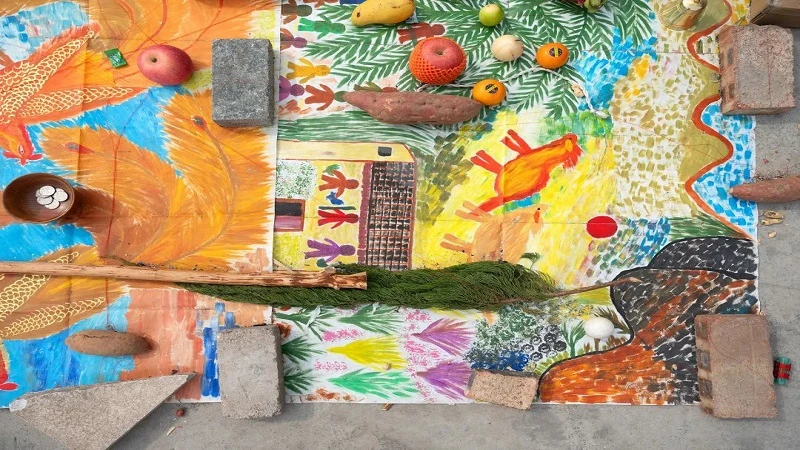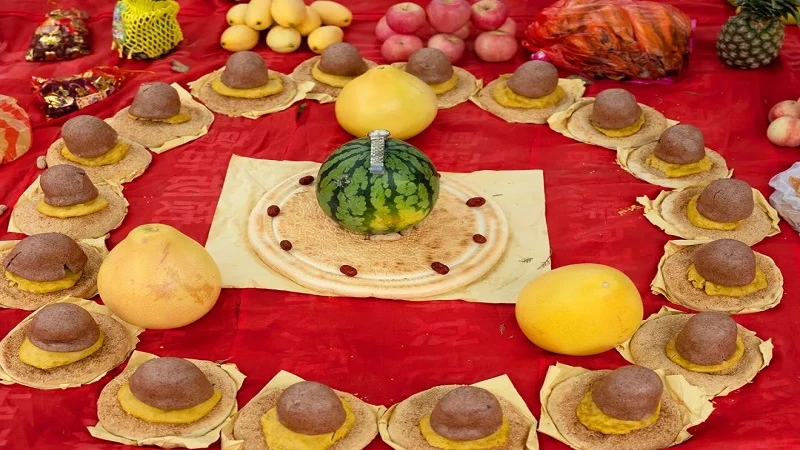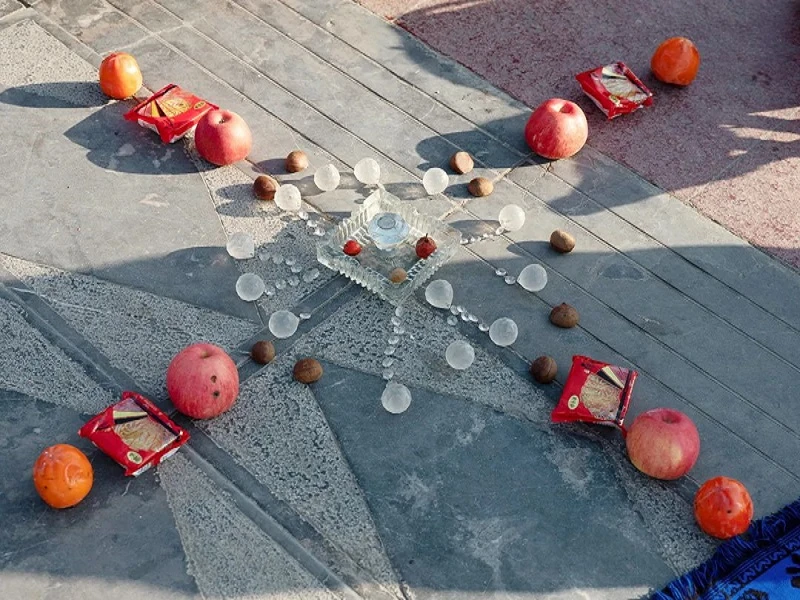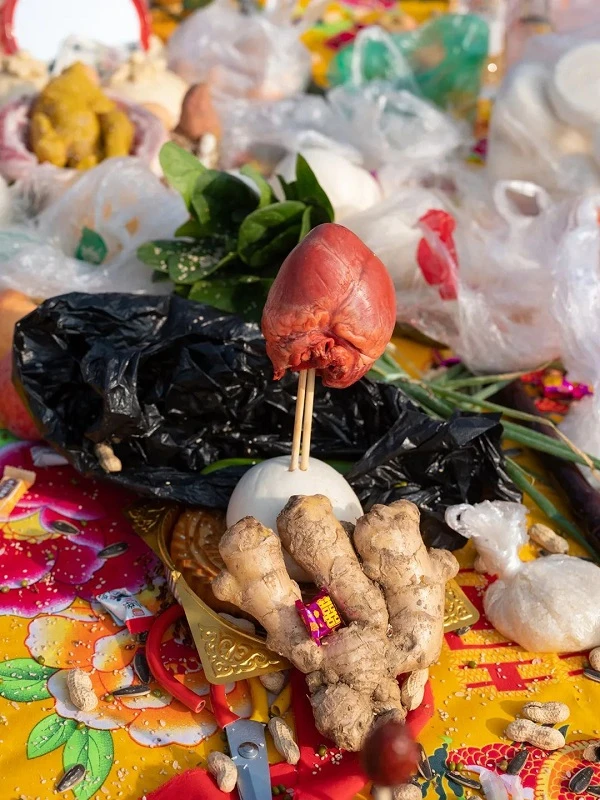In the heart of China's Central Plains, a peculiar phenomenon has unfolded quietly, hidden from mainstream attention. Every year, on certain traditional lunar calendar days, groups of individuals gather to create mesmerizing visual compositions. These arrangements, often constructed from everyday objects like cigarette packs, fruits, instant noodles, and soda bottles, are coupled with colorful watercolor paintings, forming intricate and cryptic patterns that seem to whisper messages of spiritual significance.
A Strange but Beautiful Encounter
Seven years ago, artist Zhang Xiao first stumbled upon these strange yet beautiful creations. Initially, he couldn't quite decipher their meaning—these seemingly symbolic patterns resembled an alien communication system, mysterious and perplexing. Yet, as he delved deeper, the raw, untamed beauty of the compositions revealed itself, untouched by formal aesthetic education. The art was not a product of technical mastery but rather an instinctive grasp of proportion, balance, and symmetry, as though these creators were channeling some cosmic truth beyond words.
In contrast to museum artworks, which have been analyzed and interpreted to exhaustion, these figures struck Zhang with a visceral, almost eerie power. They weren't "art" in the traditional sense but instead felt like a primal force pushing through the mundane, a testament to humanity's innate drive for creativity.
Curious about the origins of this grassroots art form, Zhang and curator Wang Huan began fieldwork three years ago, seeking to unravel the motivations behind this underground phenomenon. They discovered that these gatherings were part of a larger spiritual practice known as Pao Gong (跑功).
The Spiritual Practice of Pao Gong
Pao Gong, loosely translated as "Running Deeds," is a ritualistic practice in which participants demonstrate their faith through repeated actions. This could involve anything from frequent temple visits, walking in circles, singing, rolling on the ground, or even drawing symbols. At its core, Pao Gong is an act of devotion, using the body and mind to perform physical tasks as a show of dedication to higher powers.
There is no strict definition of what constitutes Pao Gong—anything requiring effort and sincerity can be part of the ritual. While some participants claim to receive direct instructions from a divine entity, others simply follow the vague notion of a higher force guiding their actions. For these individuals, their fate seems to be inextricably linked to this unseen power, and their purpose is to spread good deeds and spiritual merit, known as Chuan Gong (传功).
The ultimate goal of Chuan Gong is to bring blessings not just to oneself but to as many people as possible, leading to personal salvation. The more one spreads these merits, the more spiritual progress they believe they make. And so, they continue their rituals, sharing their "deeds" in creative and physical ways.
The Enigmatic Practice of Writing the Ledger
Within the Pao Gong practice, there exists a unique creative expression known as "Writing the Ledger" (写帐). This involves making art—drawing, paper-cutting, or calligraphy—where participants create symbols and patterns they believe offer a glimpse into divine mysteries.
Although no formal rules govern this practice, many participants develop a distinct personal style, repeatedly transforming, cutting, and reshaping certain figures to create a sense of organized chaos. The works, often intricate and multi-layered, leave onlookers questioning whether the creators have received formal artistic training. Yet, the artists insist that their abilities are bestowed upon them from above, adding an air of mystique to their work.
Interestingly, specific symbols and motifs are often shared and adapted within the Pao Gong community, creating a collective style that transcends individual creators. The process of "Writing the Ledger" doesn't end with creating these pieces. Participants engage in a communal experience by "Opening the Ledger" (开帐) and "Exchanging the Ledger" (交帐), during which they share their artwork with others in the group. These gatherings serve as an opportunity to decode the divine messages hidden within the drawings, seeking deeper spiritual understanding. The final step, "Submitting the Ledger", involves offering the artwork to deities by burning it at sacred sites, completing the spiritual transaction.
A Medium for Connection and Healing
For many of the participants, these practices are less about creating art and more about seeking solace and healing through the act of creation. They are building a small, shared world that allows them to communicate with each other in ways that everyday life does not afford. Within this community, they find respect and emotional comfort, something difficult to obtain in broader society.
Curator Wang Huan has long been fascinated by this intersection between grassroots creativity, spontaneous collective behavior, and the tactile relationship between people and their surroundings. His cross-cultural research project, "Secret Societies and the Drive for Art," includes the study of Pao Gong as part of a larger exploration of self-driven artistic expression. Wang believes that what makes this phenomenon so compelling is that the participants aren't concerned with creating "art" for its own sake; rather, their efforts represent a deeply personal form of spiritual communication and self-soothing.
These gatherings also foster a sense of belonging. Within the Pao Gong community, members share a common language and worldview, which strengthens their connections. It's not just about the art; it's about forming bonds through shared faith and experience. This group, often marginalized and forgotten by the modern world, finds a refuge in this collective expression.
To Zhang, their creations—these elaborate visual compositions—are their way of interpreting the cosmos. They use this symbolic language to convey their sense of self and to find communal identity. In a way, Pao Gong resembles art therapy, reaching the limits of what can be expressed through language.
If you are intrigued by these mysterious and beautiful practices, Zhang Xiao's curated exhibition, "Order from the People," showcases this underground art at the MACA gallery, offering a rare glimpse into the spiritual and artistic expressions of China's hidden Pao Gong community.




